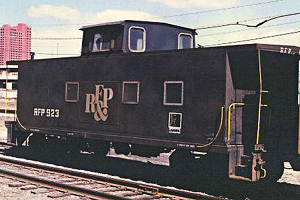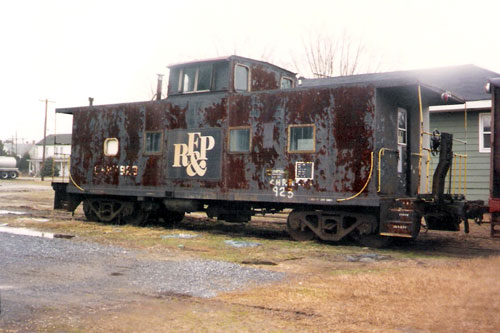RF&P 923
Richmond, Fredericksburg & Potomac Cabooses
The RF&P purchased its first modern all-steel cabooses in 1970. Until that time, the only cabooses operated by the line were numerous wooden cabooses constructed prior to 1920 and a group of converted cabooses modified from stock cars during World War II.
 The first all-steel cabooses were constructed by the International Car Company in Kenton, Ohio, and delivered to the RF&P in 1970. The cost for each car was $29,741. These first steel cabooses were wide vision, cushion underframe cabooses numbered 901 through 903. Included in the new design were such safety features as cushioned center sill, safety steps, safety glass and screens on the windows, vertical hand brakes, adjustable high-back seats and electric lights. Four additional cabooses of this design were delivered by International Car in May of 1973 and were numbered 904 through 907.
The first all-steel cabooses were constructed by the International Car Company in Kenton, Ohio, and delivered to the RF&P in 1970. The cost for each car was $29,741. These first steel cabooses were wide vision, cushion underframe cabooses numbered 901 through 903. Included in the new design were such safety features as cushioned center sill, safety steps, safety glass and screens on the windows, vertical hand brakes, adjustable high-back seats and electric lights. Four additional cabooses of this design were delivered by International Car in May of 1973 and were numbered 904 through 907.
With the beginning of the caboose pooling arrangement with Seaboard Coast Line in the early 1970s, the RF&P purchased six cars for this service. These all-steel, 50,800-pound, light weight cars were delivered by Southern Iron & Equipment of Atlanta, Georgia, in January of 1971. Numbered 921 through 923 and 931 through 933, they were placed on pool service with the SCL during the seventies and were seen all over the SCL system.
The service-life of these cabooses was interestingly extended in 1982. During that year, pursuant to the recommendations of a Presidential Emergency Board convened under the Railway Labor Act, the United Transportation Union, which represented the road trainmen, entered into a national agreement with the nation's railroads to begin the elimination of caboose cars. While the RF&P was a party to the 1982 agreement, it was unable to implement the provisions of the agreement because of a law requiring a caboose on all freight trains operating in the Commonwealth of Virginia.
 Hence, while other railroads began to eliminate or reduce the use of cabooses throughout the country in 1982, the RF&P was required to maintain a caboose on each of its freight trains. The Virginia Caboose Law was finally repealed during the 1988 session of the Virginia General Assembly.
Hence, while other railroads began to eliminate or reduce the use of cabooses throughout the country in 1982, the RF&P was required to maintain a caboose on each of its freight trains. The Virginia Caboose Law was finally repealed during the 1988 session of the Virginia General Assembly.
While the RF&P has retired virtually all of its cabooses, two of its wide vision, all-steel cabooses remain in RF&P service. In 1987, cabooses 903 and 906 were refurbished by RF&P shop forces at Bryan Park Terminal in Richmond, Virginia. These cabooses were painted bright red, Dupont #29198 Imron, with white lettering, Dupont #55769 Imron. These cars are currently used on local freight trains.
By William E. Griffin, Diesel Era Magazine, March 1991.
Reprinted with permission of Withers Publishing.
(Note: Since this article was written, all RF&P cabooses have been removed from service.)
Photo Credits: Black & White Photo: Dave Davies.
Before Renovation

After Renovation

Little Blue Caboose: Lost & Found
It was during the first half of 1987 that a curious "Lost & Found" phenomenon occurred that will never again be duplicated and, perhaps, was a taste of things to come in the railroad industry. The two-year tour of the 117th Edition of Ringling Bros. and Barnum & Bailey Circus was but three months old, and had reached the show's yearly three-week stand in Virginia (now the home state of the show's owning company, Feld Entertainment).
First the show played Norfolk, then Hampton. Richmond, usually the first Virginia town to be played each year, was last up in 1987. The next stand, Baltimore, Maryland, would see the 44-car Red Unit Circus Train move on the Richmond, Fredericksburg & Potomac Railroad and the Chessie System's former B&O rails to get there. As the show departed Richmond on the morning of Monday, March 16, a blue, 40-foot caboose, RF&P 923, went with it all the way to Baltimore, and it didn't return to Virginia for the first half of 1987, remaining with the show during its entire trek across the Northeast until June of that year! Why this occurred is a story unto itself, with both humor and a dreadful thought that, due to the pending elimination of Virginia's caboose law (repealed on July 1, 1988), the car might be soon scrapped.
After the show spent two weeks performing in Baltimore with featured elephant star King Tusk, the train carried 350 personnel, animals and equipment to the next scheduled stand: Charleston, West Virginia. RF&P 923 also went along for the ride all the way across the Allegheny Mountains on the former C&O Railway (apparently having traversed CSX's former Norfolk Southern trackage rights from Alexandria to Orange, Virginia) on March 30.
A week later, on April 5/6, the Red Unit was en route to New York City, rolling north on Amtrak's Northeast Corridor (starting at the Penn-Camden Connection north of Washington, DC), screaming along at maximum authorized Circus Train speed: 60 mph. Amtrak trains zoomed by us at twice that speed; I have the Super 8mm [sound] movies to prove it! RF&P 923 screamed along too, on the rear of the Circus Train, and all the way northward through Penn Station under New York City, and to the storage site in Queens, New York, on the Long Island Rail Road, adjacent to Harold Tower. (The show had taken LIRR routing out to Jamaica Station, then reversed direction down the freight branch.) The caboose was spotted up with the show's coaches, positioned directly underneath the Purple 7 elevated railway at the point that line begins its descent toward Manhattan and into the subway system beneath the East River.
The multi-week engagement in Madison Square Garden allowed the show personnel to make use of RF&P 923, and that we did. As an employee at that time in the show's Property Department, "Ring One" (in the show itself), I was also privileged to have the opportunity to film scenes of the caboose with my Super 8mm movie camera on "Dark Days," when the show didn't perform and the stage lights remained dark. The footage I acquired is priceless: exterior and interior shots of the caboose (the exterior was painted dark blue with the RF&P logo, and the clean, nearly dustless interior had that pale green, shiny primer paint seen in so many of that era's locomotive cabs), as well as scenes of the Circus Train storage site, including the RF&P caboose, taken from a most unique perspective: aboard a Purple 7 elevated train, as it rolled by, and above, the Long Island Rail Road storage site.
By then we were used to having RF&P 923 as part of our mile-long "mobile home." It also became a Party Car, in addition to the Tunnel Car, a former U.P. baggage car that had been used to carry equipment wagons. (That Tunnel Car came off the show-tour before the end of the decade and was recycled: it is now the Red Unit's dining car, known as the "Pie Car.")
The Red Unit's 117th Edition played in many other venues throughout the Northeast during the second quarter of 1987, and that little blue caboose went right along with us. On May 18 we jumped north from Manhattan to New Haven, Connecticut, and on May 25 continued to Hartford.
Then, on June 1, the southbound jump to Philadelphia, Pennsylvania, on Conrail's Hudson River west bank line found RF&P 923 being occupied by show personnel, and not just for railroad-related purposes: it had become accepted as a forty-fifth Circus Train car. This particular Labor Day train run was documented in a Chicory Productions VHS tape titled Hudson River Railroading, showing the train rolling along beneath the huge bridge near Bear Mountain, New York. The video focused on RF&P 923 as the train was seen disappearing around a curve, away from the camera.
Circus Caboose Madness, indeed!
During the first two weeks of June the show played the regular (yearly) scheduled, two-week stand at the Philadelphia Spectrum. This particular year it was to be followed by a rare, four-day jump all the way west to El Paso, Texas. (That long rail-ride would form the basis of the abridged feature article that was eventually published in the March 1994 issue of Passenger Train Journal, referred to as El Paso-Bound on the Pie Car's menu board on June 15-18.) While the show played Philadelphia, the circus managers, some of whom were self-admitted railfans, had actually discussed the RF&P caboose having remained with the tour since leaving Richmond several months before. Their final thoughts were that if it stayed on the train for the jump to El Paso, we would paint it silver and paste red circus banners on it, with the appropriate, at the time, RBX reporting mark and Circus Train number.
Sometimes the spoken word can have a most interesting effect. The caboose vanished in Philly. One day it was there with the Circus Train, and the next - poof! We never saw it again, and records later showed that it, like much of the nation's caboose fleet at the time, might soon face the scrapper's torch. Too bad - yet another piece of Americana slipping through our fingers, as the show might say, "Right before [our] very eyes."
But that's not the end of the story.
RF&P 923 survived the scrapper's torch and it's preserved today as part of the collection of equipment owned by the Chesapeake Railway Association in Maryland. Thank goodness for small favors! But why was it on the Circus Train for so many months during 1987, away from its home railroad, and several years before RF&P came under control of CSX? We were told later, and this is a quote, "Because the RF&P forgot about it."
RF&P 923: Little blue caboose, Lost & Found - on the Red Unit.
Postscript: At the circus, the Ringmaster always gives the audience a sincere invitation at the end of each performance. Maybe it's a good thing, or maybe it's just me: I take that phrase as a positive incentive for inviting children of all ages to return to Ringling Bros. and Barnum & Bailey the next time it comes to town. So, what has that got to do with rare railroad equipment in danger of scrapping? To them as well, I will say that famous, invitational phrase: May all your days be Circus Days!
Written by Rhett Coates; Copyright (c) 1987, 2009 Rhett Coates